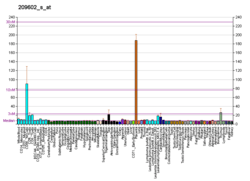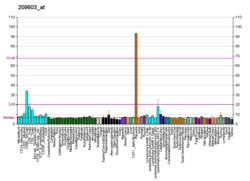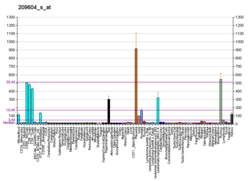GATA3
Transcription factor GATA-3 is a protein that in humans is encoded by the GATA3 gene.[3][4][5]
Function
GATA-3 belongs to the GATA family of transcription factors. It regulates luminal epithelial cell differentiation in the mammary gland.[6] The protein contains two GATA-type zinc fingers and is an important regulator of T cell development and plays an important role in endothelial cell biology. GATA-3 has been shown to promote the secretion of IL-4, IL-5, and IL-13 from Th2 cells, and induces the differentiation of Th0 cells towards this Th2 cell subtype while suppressing their differentiation towards Th1 cells.[7] It is hypothesised that GATA-3 may play tissue-specific roles.[8] It has been suggested that GATA-3 is regulated in CD4+ T cells at a transcriptional level through the IL-4 receptor, as well as translationally through T cell receptor signaling.[9]
Clinical significance
Defects in this gene are the cause of hypoparathyroidism with sensorineural deafness and renal dysplasia.
Breast cancer
GATA-3 is one of the three genes mutated in >10% of breast cancers (Cancer Genome Atlas).[10]
GATA-3 was shown to be required for the luminal A type of breast cancer, intertwined in pathways with ERα[11][12] but also androgen receptor signaling in ER-/AR+ tumors.[13]
Nuclear expression of GATA-3 in breast cancer is considered a marker of luminal cancer in ER+ cancer and luminal androgen responsive cancer in ER-/AR+ tumors.[14] It is highly coexpressed with FOXA1 and serves as negative predictor of basal subtype and ERBB2 subtype.[13][15][16] GATA-3 was shown to directly regulate luminal cell differentiation in mouse models of breast cancer.[17] It is also considered a strong predictor of taxane and platin salts insensitivity.
Insulin has been shown in experimental models to downregulate expression of GATA3 by causing overexpression of T-bet, resulting in resistance to endocrine therapy.[18]
Interactions
GATA3 has been shown to interact with LMO1,[19][20] ER and FOXA1.[16]
See also
References
- ↑ "Human PubMed Reference:".
- ↑ "Mouse PubMed Reference:".
- ↑ Joulin V, Bories D, Eléouet JF, Labastie MC, Chrétien S, Mattéi MG, Roméo PH (Jul 1991). "A T-cell specific TCR delta DNA binding protein is a member of the human GATA family". The EMBO Journal. 10 (7): 1809–16. PMC 452855
 . PMID 2050118.
. PMID 2050118. - ↑ Yamashita M, Ukai-Tadenuma M, Miyamoto T, Sugaya K, Hosokawa H, Hasegawa A, Kimura M, Taniguchi M, DeGregori J, Nakayama T (Jun 2004). "Essential role of GATA3 for the maintenance of type 2 helper T (Th2) cytokine production and chromatin remodeling at the Th2 cytokine gene loci". The Journal of Biological Chemistry. 279 (26): 26983–90. PMID 15087456. doi:10.1074/jbc.M403688200.
- ↑ "Entrez Gene: GATA3 GATA binding protein 3".
- ↑ Kouros-Mehr H, Slorach EM, Sternlicht MD, Werb Z (Dec 2006). "GATA-3 maintains the differentiation of the luminal cell fate in the mammary gland". Cell. 127 (5): 1041–55. PMC 2646406
 . PMID 17129787. doi:10.1016/j.cell.2006.09.048.
. PMID 17129787. doi:10.1016/j.cell.2006.09.048. - ↑ Yagi R, Zhu J, Paul WE (Jul 2011). "An updated view on transcription factor GATA3-mediated regulation of Th1 and Th2 cell differentiation". International Immunology. 23 (7): 415–20. PMC 3123974
 . PMID 21632975. doi:10.1093/intimm/dxr029.
. PMID 21632975. doi:10.1093/intimm/dxr029. - ↑ Wilson BJ (2008). "Does GATA3 act in tissue-specific pathways? A meta-analysis-based approach". Journal of Carcinogenesis. 7: 6. PMC 2669725
 . PMID 19008565. doi:10.4103/1477-3163.43426.
. PMID 19008565. doi:10.4103/1477-3163.43426. - ↑ Cook KD, Miller J (September 15, 2010). "TCR-dependent translational control of GATA-3 enhances Th2 differentiation". Journal of Immunology. 185 (6): 3209–3216. PMC 3993005
 . PMID 20696860. doi:10.4049/jimmunol.0902544.
. PMID 20696860. doi:10.4049/jimmunol.0902544. - ↑ Koboldt DC, Fulton RS, McLellan MD (Oct 2012). "Comprehensive molecular portraits of human breast tumours". Nature. 490 (7418): 61–70. PMC 3465532
 . PMID 23000897. doi:10.1038/nature11412.
. PMID 23000897. doi:10.1038/nature11412. - ↑ Wilson BJ, Giguère V (2008). "Meta-analysis of human cancer microarrays reveals GATA3 is integral to the estrogen receptor alpha pathway". Molecular Cancer. 7: 49. PMC 2430971
 . PMID 18533032. doi:10.1186/1476-4598-7-49.
. PMID 18533032. doi:10.1186/1476-4598-7-49. - ↑ Dydensborg AB, Rose AA, Wilson BJ, Grote D, Paquet M, Giguère V, Siegel PM, Bouchard M (Jul 2009). "GATA3 inhibits breast cancer growth and pulmonary breast cancer metastasis". Oncogene. 28 (29): 2634–42. PMID 19483726. doi:10.1038/onc.2009.126.
- 1 2 Sanga S, Broom BM, Cristini V, Edgerton ME (2009). "Gene expression meta-analysis supports existence of molecular apocrine breast cancer with a role for androgen receptor and implies interactions with ErbB family". BMC Medical Genomics. 2: 59. PMC 2753593
 . PMID 19747394. doi:10.1186/1755-8794-2-59.
. PMID 19747394. doi:10.1186/1755-8794-2-59. - ↑ Kouros-Mehr H, Kim JW, Bechis SK, Werb Z (Apr 2008). "GATA-3 and the regulation of the mammary luminal cell fate". Current Opinion in Cell Biology. 20 (2): 164–70. PMC 2397451
 . PMID 18358709. doi:10.1016/j.ceb.2008.02.003.
. PMID 18358709. doi:10.1016/j.ceb.2008.02.003. - ↑ Jacquemier J, Charafe-Jauffret E, Monville F, Esterni B, Extra JM, Houvenaeghel G, Xerri L, Bertucci F, Birnbaum D (2009). "Association of GATA3, P53, Ki67 status and vascular peritumoral invasion are strongly prognostic in luminal breast cancer". Breast Cancer Research. 11 (2): R23. PMC 2688952
 . PMID 19405945. doi:10.1186/bcr2249.
. PMID 19405945. doi:10.1186/bcr2249. - 1 2 Albergaria A, Paredes J, Sousa B, Milanezi F, Carneiro V, Bastos J, Costa S, Vieira D, Lopes N, Lam EW, Lunet N, Schmitt F (2009). "Expression of FOXA1 and GATA-3 in breast cancer: the prognostic significance in hormone receptor-negative tumours". Breast Cancer Research. 11 (3): R40. PMC 2716509
 . PMID 19549328. doi:10.1186/bcr2327.
. PMID 19549328. doi:10.1186/bcr2327. - ↑ Kouros-Mehr H, Bechis SK, Slorach EM, Littlepage LE, Egeblad M, Ewald AJ, Pai SY, Ho IC, Werb Z (Feb 2008). "GATA-3 links tumor differentiation and dissemination in a luminal breast cancer model". Cancer Cell. 13 (2): 141–52. PMC 2262951
 . PMID 18242514. doi:10.1016/j.ccr.2008.01.011.
. PMID 18242514. doi:10.1016/j.ccr.2008.01.011. - ↑ McCune K, Bhat-Nakshatri P, Thorat MA, Nephew KP, Badve S, Nakshatri H (Jan 2010). "Prognosis of hormone-dependent breast cancers: implications of the presence of dysfunctional transcriptional networks activated by insulin via the immune transcription factor T-bet". Cancer Research. 70 (2): 685–96. PMC 2807987
 . PMID 20068169. doi:10.1158/0008-5472.CAN-09-1530.
. PMID 20068169. doi:10.1158/0008-5472.CAN-09-1530. - ↑ Ono Y, Fukuhara N, Yoshie O (Dec 1998). "TAL1 and LIM-only proteins synergistically induce retinaldehyde dehydrogenase 2 expression in T-cell acute lymphoblastic leukemia by acting as cofactors for GATA3". Molecular and Cellular Biology. 18 (12): 6939–50. PMC 109277
 . PMID 9819382.
. PMID 9819382. - ↑ Ono Y, Fukuhara N, Yoshie O (Feb 1997). "Transcriptional activity of TAL1 in T cell acute lymphoblastic leukemia (T-ALL) requires RBTN1 or -2 and induces TALLA1, a highly specific tumor marker of T-ALL". The Journal of Biological Chemistry. 272 (7): 4576–81. PMID 9020185. doi:10.1074/jbc.272.7.4576.
Further reading
- Naylor MJ, Ormandy CJ (2007). "Gata-3 and mammary cell fate". Breast Cancer Research. 9 (2): 302. PMC 1868924
 . PMID 17381824. doi:10.1186/bcr1661.
. PMID 17381824. doi:10.1186/bcr1661. - Ho IC, Vorhees P, Marin N, Oakley BK, Tsai SF, Orkin SH, Leiden JM (May 1991). "Human GATA-3: a lineage-restricted transcription factor that regulates the expression of the T cell receptor alpha gene". The EMBO Journal. 10 (5): 1187–92. PMC 452772
 . PMID 1827068.
. PMID 1827068. - Marine J, Winoto A (Aug 1991). "The human enhancer-binding protein Gata3 binds to several T-cell receptor regulatory elements". Proceedings of the National Academy of Sciences of the United States of America. 88 (16): 7284–8. PMC 52279
 . PMID 1871134. doi:10.1073/pnas.88.16.7284.
. PMID 1871134. doi:10.1073/pnas.88.16.7284. - Ko LJ, Yamamoto M, Leonard MW, George KM, Ting P, Engel JD (May 1991). "Murine and human T-lymphocyte GATA-3 factors mediate transcription through a cis-regulatory element within the human T-cell receptor delta gene enhancer". Molecular and Cellular Biology. 11 (5): 2778–84. PMC 360054
 . PMID 2017177. doi:10.1128/mcb.11.5.2778.
. PMID 2017177. doi:10.1128/mcb.11.5.2778. - Siegel MD, Zhang DH, Ray P, Ray A (Oct 1995). "Activation of the interleukin-5 promoter by cAMP in murine EL-4 cells requires the GATA-3 and CLE0 elements". The Journal of Biological Chemistry. 270 (41): 24548–55. PMID 7592673. doi:10.1074/jbc.270.41.24548.
- Labastie MC, Bories D, Chabret C, Grégoire JM, Chrétien S, Roméo PH (May 1994). "Structure and expression of the human GATA3 gene". Genomics. 21 (1): 1–6. PMID 8088776. doi:10.1006/geno.1994.1217.
- Ono Y, Fukuhara N, Yoshie O (Feb 1997). "Transcriptional activity of TAL1 in T cell acute lymphoblastic leukemia (T-ALL) requires RBTN1 or -2 and induces TALLA1, a highly specific tumor marker of T-ALL". The Journal of Biological Chemistry. 272 (7): 4576–81. PMID 9020185. doi:10.1074/jbc.272.7.4576.
- Ono Y, Fukuhara N, Yoshie O (Dec 1998). "TAL1 and LIM-only proteins synergistically induce retinaldehyde dehydrogenase 2 expression in T-cell acute lymphoblastic leukemia by acting as cofactors for GATA3". Molecular and Cellular Biology. 18 (12): 6939–50. PMC 109277
 . PMID 9819382.
. PMID 9819382. - Yang GP, Ross DT, Kuang WW, Brown PO, Weigel RJ (Mar 1999). "Combining SSH and cDNA microarrays for rapid identification of differentially expressed genes". Nucleic Acids Research. 27 (6): 1517–23. PMC 148347
 . PMID 10037815. doi:10.1093/nar/27.6.1517.
. PMID 10037815. doi:10.1093/nar/27.6.1517. - Blumenthal SG, Aichele G, Wirth T, Czernilofsky AP, Nordheim A, Dittmer J (Apr 1999). "Regulation of the human interleukin-5 promoter by Ets transcription factors. Ets1 and Ets2, but not Elf-1, cooperate with GATA3 and HTLV-I Tax1". The Journal of Biological Chemistry. 274 (18): 12910–6. PMID 10212281. doi:10.1074/jbc.274.18.12910.
- Van Esch H, Groenen P, Nesbit MA, Schuffenhauer S, Lichtner P, Vanderlinden G, Harding B, Beetz R, Bilous RW, Holdaway I, Shaw NJ, Fryns JP, Van de Ven W, Thakker RV, Devriendt K (Jul 2000). "GATA3 haplo-insufficiency causes human HDR syndrome". Nature. 406 (6794): 419–22. PMID 10935639. doi:10.1038/35019088.
- Hartley JL, Temple GF, Brasch MA (Nov 2000). "DNA cloning using in vitro site-specific recombination". Genome Research. 10 (11): 1788–95. PMC 310948
 . PMID 11076863. doi:10.1101/gr.143000.
. PMID 11076863. doi:10.1101/gr.143000. - Muroya K, Hasegawa T, Ito Y, Nagai T, Isotani H, Iwata Y, Yamamoto K, Fujimoto S, Seishu S, Fukushima Y, Hasegawa Y, Ogata T (Jun 2001). "GATA3 abnormalities and the phenotypic spectrum of HDR syndrome". Journal of Medical Genetics. 38 (6): 374–80. PMC 1734904
 . PMID 11389161. doi:10.1136/jmg.38.6.374.
. PMID 11389161. doi:10.1136/jmg.38.6.374. - Crawford SE, Qi C, Misra P, Stellmach V, Rao MS, Engel JD, Zhu Y, Reddy JK (Feb 2002). "Defects of the heart, eye, and megakaryocytes in peroxisome proliferator activator receptor-binding protein (PBP) null embryos implicate GATA family of transcription factors". The Journal of Biological Chemistry. 277 (5): 3585–92. PMID 11724781. doi:10.1074/jbc.M107995200.
- Kieffer LJ, Greally JM, Landres I, Nag S, Nakajima Y, Kohwi-Shigematsu T, Kavathas PB (Apr 2002). "Identification of a candidate regulatory region in the human CD8 gene complex by colocalization of DNase I hypersensitive sites and matrix attachment regions which bind SATB1 and GATA-3". Journal of Immunology. 168 (8): 3915–22. PMID 11937547. doi:10.4049/jimmunol.168.8.3915.
- Asnagli H, Afkarian M, Murphy KM (May 2002). "Cutting edge: Identification of an alternative GATA-3 promoter directing tissue-specific gene expression in mouse and human". Journal of Immunology. 168 (9): 4268–71. PMID 11970965. doi:10.4049/jimmunol.168.9.4268.
- Steenbergen RD, OudeEngberink VE, Kramer D, Schrijnemakers HF, Verheijen RH, Meijer CJ, Snijders PJ (Jun 2002). "Down-regulation of GATA-3 expression during human papillomavirus-mediated immortalization and cervical carcinogenesis". The American Journal of Pathology. 160 (6): 1945–51. PMC 1850837
 . PMID 12057898. doi:10.1016/S0002-9440(10)61143-1.
. PMID 12057898. doi:10.1016/S0002-9440(10)61143-1. - Höfer T, Nathansen H, Löhning M, Radbruch A, Heinrich R (Jul 2002). "GATA-3 transcriptional imprinting in Th2 lymphocytes: a mathematical model". Proceedings of the National Academy of Sciences of the United States of America. 99 (14): 9364–8. PMC 123146
 . PMID 12087127. doi:10.1073/pnas.142284699.
. PMID 12087127. doi:10.1073/pnas.142284699. - Karunaratne A, Hargrave M, Poh A, Yamada T (Sep 2002). "GATA proteins identify a novel ventral interneuron subclass in the developing chick spinal cord". Developmental Biology. 249 (1): 30–43. PMID 12217316. doi:10.1006/dbio.2002.0754.
External links
- GATA3 protein, human at the US National Library of Medicine Medical Subject Headings (MeSH)
- FactorBook GATA3
This article incorporates text from the United States National Library of Medicine, which is in the public domain.


